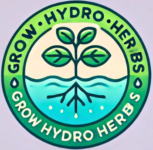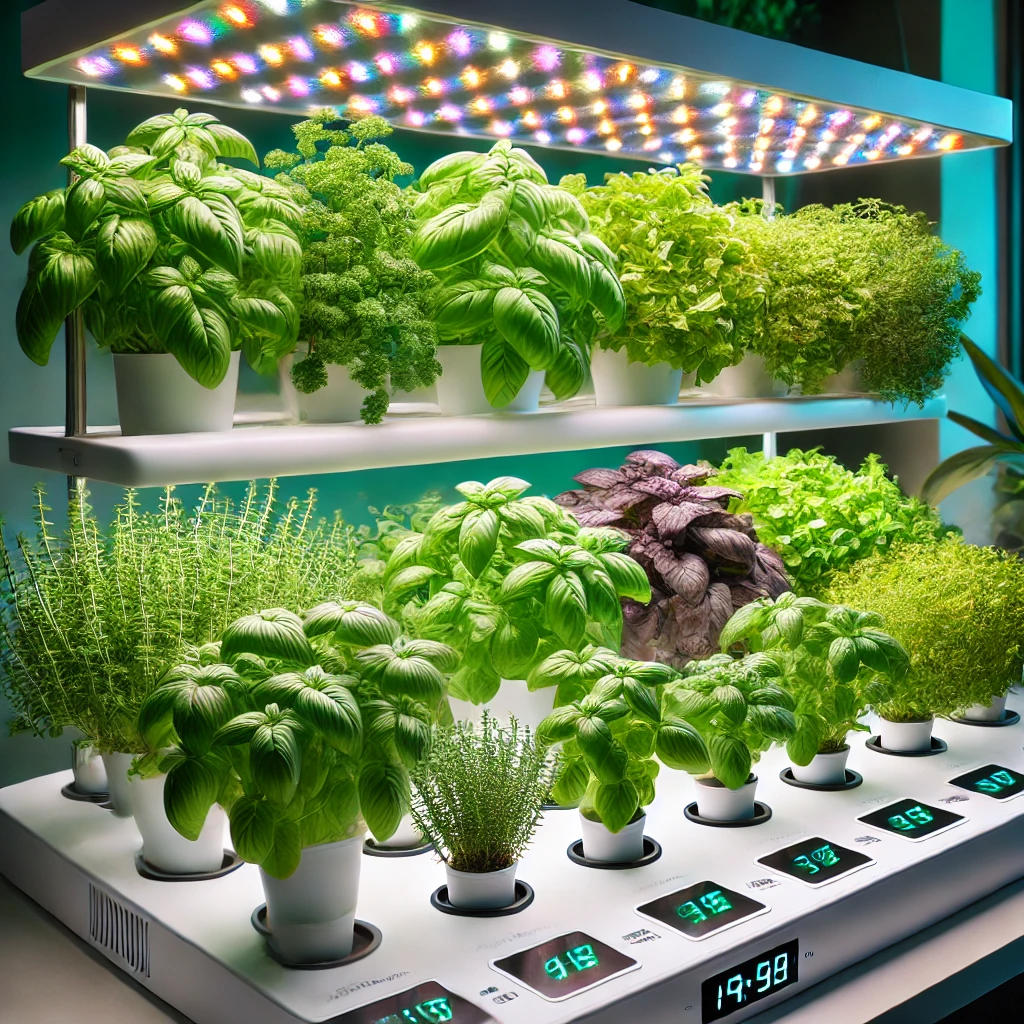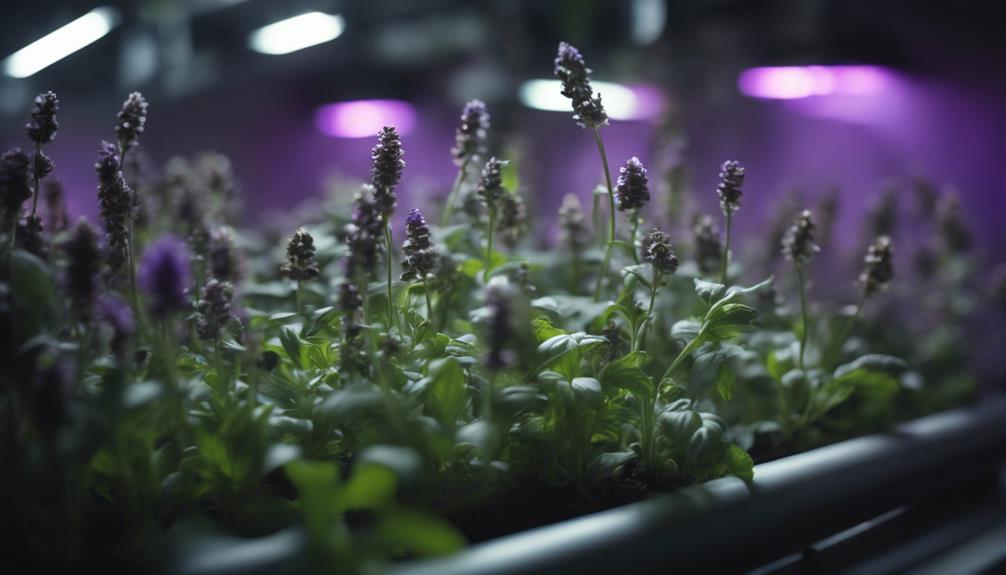A Spotlight on Hydroponic Herb Light Requirements
For thriving hydroponic herbs, it’s essential to meet their light needs. Let’s explore hydroponic herb light requirements.
Ensuring they get 14-16 hours of light daily helps with growth. LED lights come in handy to provide the right spectrum for your herbs. Blue light boosts vegetative growth, while red light aids in flowering.
Remember to adjust the light duration to suit each growth stage. South-facing windows can offer great natural light, but rotating herbs prevents leaf burn. Consider supplementing with artificial lights for consistent growth.
Get the best out of your hydroponic herbs with these light requirements!
GrowHydroHerbs TLDR
- Herbs require 14-16 hours of light daily for optimal growth.
- Use LED grow lights with the right spectrum for herbs.
- Adjust light duration based on growth stage.
- Position lights to prevent burning or stretching.
- Consistent light schedules mimic natural sunlight conditions.
Why is Light Important for Hydroponic Herbs?

Light plays an essential role in the growth and development of hydroponic herbs. Ensure the appropriate amount of light when setting up your hydroponic herb garden.
Herbs, like basil, mint, or parsley, require sufficient light to carry out photosynthesis. Without enough light, the plants may become leggy, with weak stems and pale leaves.
Guarantee your hydroponic herbs receive the light they need. To do this, consider factors such as intensity, duration, and spectrum. Intensity refers to the brightness of the light. Most herbs require around 14-16 hours of light per day.
Duration is equally important. Providing consistent light schedules helps mimic natural sunlight conditions.
Additionally, understanding the light spectrum can greatly impact your herb’s growth. Different light wavelengths promote various stages of plant development. For instance, blue light is critical for vegetative growth. Red light is essential for flowering and fruiting.
What does Light Spectrum Mean for Herbs?

To optimize your hydroponic herb growth, one needs to understand the light spectrum. Different wavelengths of light play a key role in various stages of herb development.
Light Spectrum Essentials
The light spectrum essential for herbs can greatly impact herb growth and development. Providing the right light spectrum is vital for hydroponic herb cultivation. It helps optimize photosynthesis and contributes to overall plant health.
Different wavelengths of light play specific roles in the growth stages of herbs. Here are the key components of the light spectrum and their effects on herb growth:
| Light Spectrum Range | Light Color | Function |
|---|---|---|
| 400-500 nm | Blue | Stimulates vegetative growth and enhances leaf development |
| 500-600 nm | Green | Plays a minor role in photosynthesis |
| 600-700 nm | Red | Essential for flowering and fruiting stages |
Herb Growth Optimization
Let’s learn how different light spectrums impact herb development.
Understanding the varying needs of different herbs is important. It contributes to optimizing herb growth through light spectrum. Herbs like basil and cilantro thrive under blue spectrum light. Blue light promotes leafy green growth. Flowering herbs such as lavender or chamomile require more red spectrum light. Red light stimulates blooming and essential oil production.
Consider using LED hydroponic grow lights. These lights allow you to adjust the light spectrum based on the specific growth stage of your herbs.
Provide a higher proportion of blue light during the vegetative stage. This will encourage robust leaf development.
Increase the red light component as herbs progress to the flowering stage. This will support flowering and fruiting.
What Factors Affect Light Intensity?

Two key factors are important when it comes to optimizing light intensity for your hydroponic herbs. First, the specific light spectrum needed for growth. Second, the duration of light exposure. Understanding these can help you create the ideal environment for your herbs to thrive.
Adjust these variables according to your herb’s needs. This will guarantee they receive the perfect amount of light for healthy growth.
Light Spectrum for Growth
So, let’s dive into the light spectrum for growth. The light spectrum plays a critical role in determining how well your herbs will thrive.
Plants have specific light spectrum requirements for different stages of growth.
Blue light is important for promoting vegetative growth. It encourages compact and leafy plants.
Red light is essential for flowering and fruiting stages. This light aids in the production of flowers and fruits.
Green light is less efficiently utilized by plants. However, it can penetrate deeper into the canopy, helping with overall plant development.
Make sure you provide a balanced light spectrum when setting up your hydroponic herb garden. That way it meets the needs of your plants throughout their growth cycle.
Understand the significance of different light spectrums. Then, you can create an ideal environment for your herbs. They will flourish and thrive in your hydroponic system!
Duration of Light
Proper management of light duration maintains light intensity for your hydroponic herb garden. The duration of light exposure will impact the growth and development of your herbs.
There are factors such as the specific herb species, growth stage, and environmental conditions. These play a vital role in determining the best duration of light needed.
For most herbs, 14-16 hours of light per day during the vegetative stage is recommended. As the herbs progress into the flowering or fruiting stage, adjusting the light duration to 10-12 hours per day can promote better yields.
Exceeding the recommended light duration can lead to stress and hinder growth. Insufficient light exposure may result in leggy and weak plants.
Make certain your hydroponic herbs receive the right amount of light. Consider using a timer to regulate the light cycle consistently.
Monitoring the duration of light exposure can create an ideal growing environment for your herbs. Doing so maximizes their productivity.
What is the Best Duration of Light Exposure for Hydroponic Herbs?
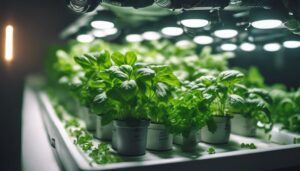
Maintain the appropriate duration of light exposure in a hydroponic system. Doing so can result in the successful growth of herbs. In general, most herbs grown hydroponically require around 14 to 16 hours of light per day to thrive. This consistent exposure to light is vital for photosynthesis. Photosynthesis is a process by which plants convert light into energy.
What is the ideal duration of light exposure for your hydroponic herbs? When determining it, it’s important to take into account the specific requirements of the herbs you’re growing.
Some herbs, like basil and cilantro, are classified as long-day plants. That means they thrive with longer periods of light exposure. Others, such as parsley and chives, are classified as short-day herbs. These herbs require shorter durations of light exposure to flourish.
To ensure optimal growth use a timer to control the duration of light exposure. Provide your herbs with the right amount of light each day. Then you can support healthy growth and maximize your harvest.
What are the Best Natural Light Conditions for Herbs?
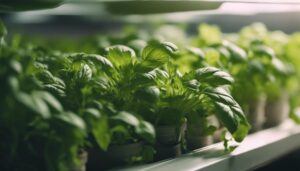
You must know the best light conditions for the ideal growth of your hydroponic herbs.
Herbs thrive in bright, indirect sunlight. Placing your hydroponic system near a south-facing window is ideal. East or west-facing windows can also provide sufficient light. However, you may need to rotate your herbs periodically to guarantee even exposure.
Direct sunlight can be too intense for herbs. It may lead to leaf burn, so it’s important to filter the light through sheer curtains or blinds.
Keep in mind that different herbs have varying light requirements. Basil and mint prefer around 6-8 hours of sunlight per day. Cilantro and parsley can thrive with slightly less, around 4-6 hours. If natural light is insufficient, supplementing with artificial grow lights can help meet the herbs’ needs.
Remember to monitor the light levels regularly. The changing seasons can affect the intensity and duration of natural light. ,
Providing your herbs with the best natural light conditions. That will ensure robust growth and flavorful harvests
How to Choose Artificial Lighting for Hydroponics?
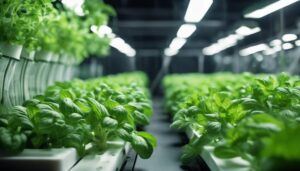
What about an indoor light system when sunlight isn’t available?
How to choose artificial light source for your hydroponic garden? Choose the right type and intensity to support healthy plant growth.
Here are four factors to take into account when selecting artificial lighting for your hydroponic herb garden:
- Light Spectrum: Different plants have varying light spectrum needs. Your hydroponic lighting system should provide a spectrum suitable for herbs. This will promote photosynthesis and overall growth.
- Light Intensity: The intensity of the light affects plant growth rates. Ensure your lighting setup can deliver the required light intensity for the specific herbs you’re growing.
- Energy Efficiency: Choose energy-efficient lighting options. This will reduce operating costs and minimize environmental impact. Even while still providing ample light for your herbs.
- Durability: Choose lighting fixtures that are durable and long-lasting. This will avoid frequent replacements and ensure continuous support for your hydroponic herbs.
LED Vs. Fluorescent Lighting for Herbs: How to Compare?
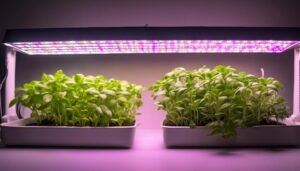
Consider the efficiency and effectiveness of LED versus fluorescent lighting.
LED lights are a popular choice for hydroponic herb gardens. This is due to their energy efficiency and targeted light spectrum. LEDs consume less electricity compared to fluorescents and produce less heat. Thus, reducing the risk of damaging your herbs. Additionally, LED lights have a longer lifespan. This will save you money in the long run by not needing frequent replacements.
Fluorescent lights, on the other hand, are initially cheaper to purchase. However, they may end up costing more in the long term. This is due to higher energy consumption and shorter lifespans. They also emit more heat. This can be detrimental to the health of your herbs if not properly managed. However, fluorescent lights are readily available. Further, they can be a good option for beginners or those on a budget.
Consider factors like:
- energy efficiency
- heat emission
- lifespan
- initial cost
These factors help when choosing between LED and fluorescent lighting for your hydroponic herb garden. This will help determine which type of light best suits your needs and budget.
What Are Some Tips for Optimizing Light in Hydroponic Systems?
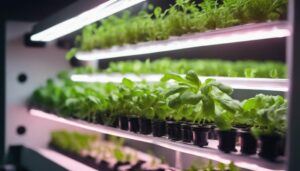
To maximize growth and health in your hydroponic system, make sure that your lighting setup is optimized for your herbs’ needs. Proper lighting is essential for the success of your hydroponic herb garden.
Here are some tips to help you optimize light in your hydroponic system:
- Positioning is Key. Place your grow lights at the correct height above your herbs. Too close can cause burning, while too far will result in stretching.
- Consistent Light Schedule. Maintain a consistent light schedule for your herbs. Aim for around 14-16 hours of light per day to mimic natural conditions.
- Invest in Quality Lights. Choose high-quality LED or fluorescent lights specifically designed for plant growth. They may cost more initially, but they’ll benefit your herbs in the long run.
- Rotate Herbs Regularly. Make certain all parts of your herbs receive adequate light. Rotate them regularly within your hydroponic system.
What Did We Learn About Hydroponic Herb Light Requirements?
Ensuring your hydroponic herbs receive the right amount of light is essential for their growth and overall health.
By understanding the light spectrum, intensity, and duration of exposure, you can optimize your herb garden for success.
Proper lighting will help your herbs thrive in a hydroponic system. This is true whether you use natural light or artificial lighting options like LED or fluorescent.
Don’t overlook the importance of light in your herb-growing journey.
